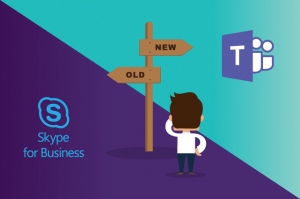Extra! Extra! Have you heard the news? Microsoft has announced the retirement date for Skype for Business! Yes, that means Skype will be no more come July 31, 2021. Although it may be a little sad to say farewell to Skype, it is also an exciting time to begin transitioning to the collaborative tool that will be replacing it, Microsoft Teams. Microsoft Teams expands on the capabilities offered in Skype for Business by bringing together functionality that enables organizations to move faster and collaborate more efficiently.
You may be wondering what the difference is between Skype for Business and Microsoft Teams. An easy way of thinking about it is that Skype is simply a communications tool used for chatting, audio/video calling, and virtual meetings. Teams does all of that— and much more! Teams encompasses the functionality of Skype while integrating SharePoint, OneDrive, and Yammer functionality, as well as, the ability to customize and incorporate additional Microsoft applications.
Think of Microsoft Teams as a central hub for all your communication and collaboration needs! Teams combines chat, audio & video calling, virtual meetings, file sharing, and forum-style communication. It’s designed as a digital workspace where teams can collaborate and share information quickly and easily on the go. Making the switch from Skype to Teams is more than introducing added features and functionality— it’s about changing the way employees work, collaborate, and communicate in order to get the most out of ALL the capabilities Teams has to offer.
This is more of a behavioral transformation than a technology transition and should be treated as a robust adoption and change management effort. It is important for organizations to start preparing and planning for this transformation using adoption and change management strategies, in order to seamlessly drive user adoption of Teams.
Here are some key adoption and change management considerations before launching Microsoft Teams:
- Assess organizational readiness for change: Determine your organization’s level of readiness for change by asking questions that measure their attitude and awareness of the change. This will help gauge any gaps and areas of the organization that are at risk for low adoption.
- Establish executive sponsorship and a change champion network: Microsoft has found that these two factors are the most important aspect of driving user adoption of Teams. The importance of having a change champion network and executive sponsorship is critical to getting users to buy-in and engage in the change and drive adoption.
- Conduct a teamwork analysis: Since Teams is a collaborative tool, it is useful to analyze how groups in your organization are currently working and collaborating in order to understand how they can best utilize Teams.
- Determine any hindrances to adoption: It is important to dive deep and explore any possible risks to adoption before you begin transitioning. For example, one risk could involve a department or team using an additional communication and collaboration tools that is not used throughout the organization to compensate for a gap in the current technology offered. Identifying and addressing these risks will help ensure Teams meets every communication and collaboration need within the organization.
If you are interested in learning how organizational change management can support the successful migration to and adoption of Office 365 and Microsoft Teams, please join us on November 14, 2019 for a webinar: Driving Office 365 and Microsoft Teams User Adoption: What you should know before embarking on your implementation.

